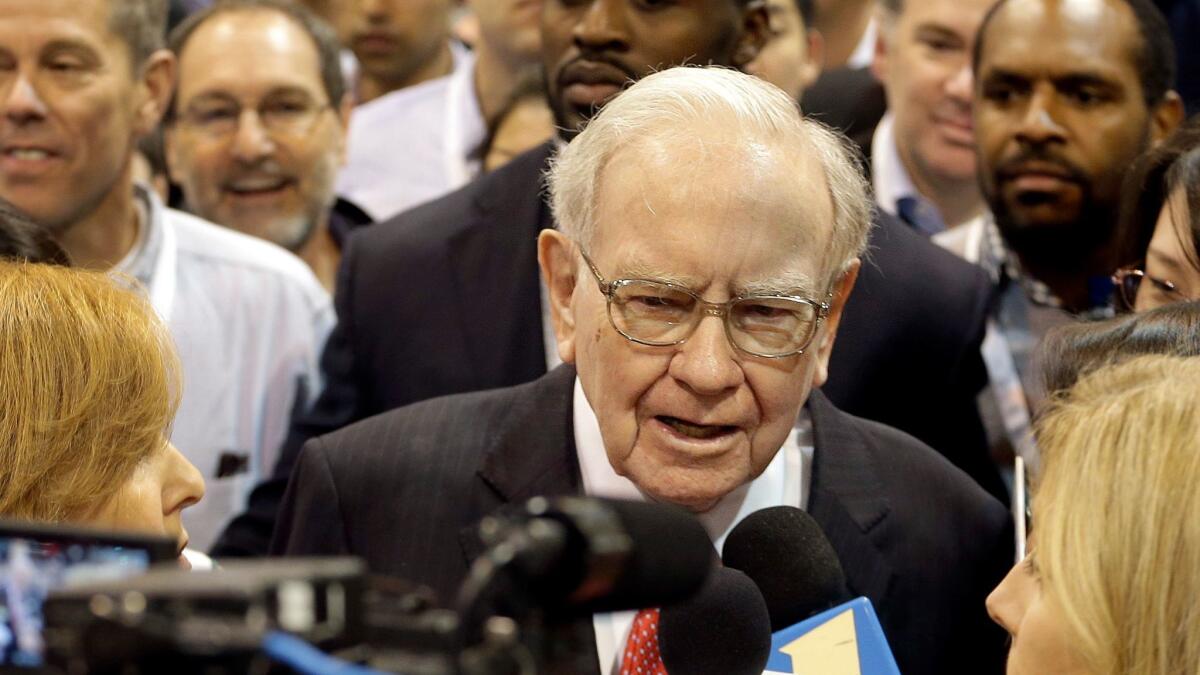Column: Reducing healthcare costs doesn’t require Bezos/Buffett/Dimon magic: Every other country already knows how

- Share via
There were a couple of endearingly all-American aspects to Tuesday’s announcement of a joint venture by Jeff Bezos of Amazon, Warren Buffett of Berkshire Hathaway and Jamie Dimon of JPMorgan Chase to reduce healthcare costs.
One was the American conviction that determined billionaires can solve any problem they set their minds to. And three billionaires together — that’s like a billionaire cubed, right?
Another was the attitude that because America hasn’t found a way to reduce healthcare costs, no one else must know how — the problem must be unsolvable, except perhaps through the magic of technology. Preferably technology that hasn’t been invented yet.
In their joint statement, Bezos, Buffett and Dimon said their firms would create “an independent company that is free from profit-making incentives and constraints” to focus on “technology solutions” to the healthcare cost mystery.
We have good ideas on how to reduce costs. They mainly involve ... saying ‘No’ or at least saying ‘No, not at this price.’
— David Anderson, Duke University
The three CEOs didn’t offer much more detail than that, but still managed to throw healthcare companies for a loop, contributing to stock market losses for drug companies, hospital networks and health insurers.
“The ballooning costs of healthcare act as a hungry tapeworm on the American economy,” Buffett said in the statement. “Our group does not come to this problem with answers. But we also do not accept it as inevitable.”
That’s good, because it’s already clear that healthcare costs on the American scale aren’t “inevitable.” We know this because no other developed country in the world has healthcare costs as high as ours. The U.S. spends $9,451 per capita (as of 2015) on healthcare; the average among other wealthy countries is about $4,908. The U.S. spends about 18% of its gross domestic product on healthcare; the average among comparable countries is 9%.
But we get what we pay for, right? Wrong. America does relatively well in cancer care, but worse than other developed countries in heart disease mortality. Our infant mortality rate is the highest among developed countries, life expectancy at birth the lowest.
Because Messrs. Bezos, Buffett and Dimon didn’t work a global perspective into their hand-wringing analysis, they failed to see the American crisis in healthcare costs for what it is: a political problem, not a “technological” problem.
The truth is that the cause of America’s healthcare costs is widely and well understood. Healthcare experts Gerard F. Anderson of Johns Hopkins and the late Uwe Reinhardt of Princeton put it succinctly in a paper they presented in 2003, entitled: “It’s the Prices, Stupid.”
The United States actually compares unfavorably, they found, to other countries in the OECD, or Organization for Economic Co-Operation and Development, a group of 35 developed and market-oriented countries. Americans had fewer hospital admissions per capita and shorter stays per admission, for example, but paid more per admission and per day. The same goes for pharmaceutical prices — the U.S. paid the highest prices, by far, for drugs.
“We have good ideas on how to reduce costs,” health insurance expert David Anderson of Duke University observed following the billionaires’ announcement. “They mainly involve a variety of ways of saying ‘No’ or at least saying ‘No, not at this price.’”
Bezos, Buffett and Dimon didn’t even have to look beyond the U.S. boundaries to find clues to how to reduce healthcare costs — they merely had to look at America’s public healthcare programs such as Medicare, Medicaid and CHIP. All place limits on reimbursements to doctors and hospitals, some more stringent than others.
But they have been quite successful in controlling costs. As the Kaiser Family Foundation has shown, the spending by America’s public healthcare programs very closely matches that of other developed countries, at about 8.4% of GDP. Where the U.S. is an outlier is in spending by the private sector, through commercial health insurance. There the U.S. spends another 8.6% of its GDP on healthcare, compared with only 2.4% by other countries.
Why is that? In part because incentives for private insurers to hold down spending are few. Under the Affordable Care Act, for instance, they’re held to a fixed profit of 15% to 20%, which obviously rises as their payments to providers rise. To the extent that consortiums or middlemen such as pharmacy benefit managers get involved, they often keep whatever savings they extract from providers for themselves; the excess spending remains in the system, but just gets distributed differently.
The potential of these arrangements to cut costs out of the system is something of a scam. Consider the proposed merger of drug retailer CVS and health insurer Aetna. The companies have depicted the deal as bringing the nirvana of lower prices to consumers. In truth, it’s really designed to capture more of the bonanza of healthcare spending for the merger partners. Maybe they’ll pass on some crumbs to consumers, but no one should expect a banquet.
Press coverage of Tuesday’s announcement touted the huge footprint of the three companies in terms of their combined workforces — with more than 1 million employees among them (including foreign workers), they have the critical mass to make a difference. So the argument goes, anyway.
But a patient base that size is hardly unique. CalPERS, to name one healthcare customer, manages healthcare for 1.4 million state and local employees in California. The Federal Employees Health Benefits Program, or FEHBP, covers 8 million. Sometimes they’ve been able to hold the line on healthcare spending, sometimes not. But there’s no reason to assume that Amazon, Berkshire and JPM will come up with anything new they haven’t tried. By the way, neither CalPERS nor FEHBP has the sort of “profit-making incentives and constraints” that the three company CEOs say are a driver of costs.
The problem of healthcare costs in the U.S. boils down to political will and political power. The healthcare provider lobby comprises hospitals, physicians, pharmaceutical companies, device manufacturers and health insurers. All have an interest, individually and combined, to fight efforts to cut their take of an ever-growing pie.
Their wholly owned subsidiary, the U.S. Congress, does their dirty work. That’s why proposals to cap pharmaceutical costs, reduce provider reimbursements, or develop a public option to compete with private insurance all die before their committee hearings are gaveled to a close.
And if any initiatives survive attacks by these private lobbies, ideologues in the House and Senate are available to finish the job. Republicans spent seven years trying to kill the Affordable Care Act, which has numerous provisions aimed at slowing the growth of healthcare spending — some of which have shown success. Then the GOP congratulated itself for undermining the law, in a way that will raise costs for millions of Americans and deprive them of the most efficient healthcare.
Instead of pondering the deep mysteries of why U.S. healthcare costs are so high, Bezos, Buffett and Dimon could have stood upon their bully pulpits and called for an end to this sabotage of the Affordable Care Act. That would have saved plenty of money. They were silent.
What the three CEOs produced on Tuesday, as Duke’s Anderson pointed out, was a press release, not answers. If they really do “not come to this problem with answers,” as Buffett said, then they haven’t been looking very hard.
Keep up to date with Michael Hiltzik. Follow @hiltzikm on Twitter, see his Facebook page, or email [email protected].
Return to Michael Hiltzik’s blog.
More to Read
Inside the business of entertainment
The Wide Shot brings you news, analysis and insights on everything from streaming wars to production — and what it all means for the future.
You may occasionally receive promotional content from the Los Angeles Times.











